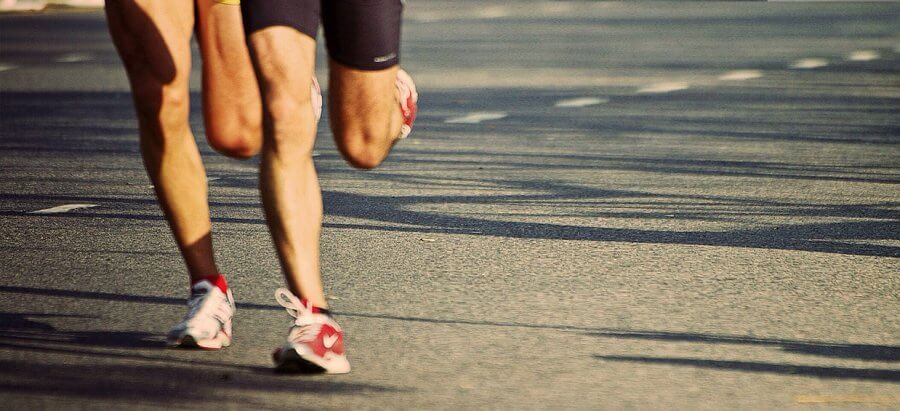What Is Tapering & How Does It Affect Race Performance?

Whether you are a distance runner, a competitive swimmer or a cyclist, tapering prior to a big goal race is a common practice. If you are unfamiliar with tapering, it is actually a pretty straightforward concept.
What Is Tapering?
Tapering is when you make a gradual decrease in the amount of physical activity you are engaging in as you get closer to your event day. The length of time that you taper can vary depending on what you are training for.
It is important to know that if you are training for a big event and have smaller events leading up to that one big day, you will likely not experience any type of real taper prior to the “big one.”
I like to liken this to a high school athlete in a customary track and field season. If you think back to your teenage years, your coach may have given you a light workout the night before a meet, but you did continue to run through most meets. What I mean by that is each smaller meet was a tuneup meet leading to the big event.
The same is true for your running today. If you are training for a marathon, you will often have a half marathon neatly wedged somewhere in the midst of the training program. Coaches call this a tune-up race.
If you look closely at your training plan, you might notice that there are a couple of easier days prior to this race, but no real cut in mileage. That is called training through a race.
Why? Because the marathon is the Main Event!
Does Tapering Really Work?
Studies show that tapering can give an athlete up to a 3% improvement in performance. For elite runners, and others who have taken their training to a higher level, tapers can sometimes provide closer to 5% improvement. The thing about tapering is the athlete has to take that portion of training as seriously as the rest of it.
As a women’s competitive swimming team coach for 12 years, we plowed right through the bulk of the season hammering away with two-a-day practices multiple times a week. With the girls swimming upwards of 10,000 yards at least three days each week, they were always ready for the taper to begin.

One thing athletes need to consider during taper is that if you are going from very high volume workouts to very low volume, you should take care to be cognizant of what you are fueling your body with.
I am not one to food shame and believe that athletes need to eat; however, when you go from serious work like 10,000 yards in a day to 4,000 yards in a day, your body and brain take a hot minute to catch up.
A swimmer can easily overeat themselves through a few days of taper before the body recognizes they are no longer fueling such arduous workouts.
Multifaceted Aspects Of Taper
Some athletes are super excited to decrease mileage and don’t consider the other important aspects of taper. So here we go!
Baby Your Body: Taper is a time to take extra care with yourself and baby your body. This means you should take that soak in the tub and add some Epsom salts. Take your partner up on that back massage. Reunite with your foam roller.
Proper Nutrition: Hone in on your diet during this period. Cut out processed food and sugars. Avoid junk food. Treat your body like the temple that it is.
Lower Mileage: Here is where you start to lower your overall weekly mileage, and your longest runs get shorter. The plan is for you to toe the line on race day with fresh legs.
Less Intense Workouts: To ensure those fresh legs mentioned above, you are going to cut back on track, tempo, and other types of speed work. I am not saying your coach won’t assign any. Just that you will be making it easier for the duration of this cycle.
Visualization: This one is an important one that many, many people overlook. You should take time to visualize your race and success on race day. A form of medication, visualization can completely change your mindset.
Positive Attitude: Lastly, choose a positive attitude. That coworker who makes you crazy? Don’t let her suck you into her crazy. You are choosing a fantastic attitude as you taper toward a successful race.
Do You Really Need To Taper?
Need to taper? Well, no. Needs include food, water, air… stuff like that. None of us needs to taper. But it sure can help! The taper provides a physical advantage as you gear up to race day.
In addition, it helps you get emotionally ready to race. If you choose to taper I firmly believe you are putting your body in the best possible position for race day.
Benefits of tapering in sports:
- Replenishing glycogen stores.
- Giving your body and rest.
- Helping your mind to reset and focus.
- Muscle repair.
- Reduction of fatigue.
How Long Should You Taper?
Studies show that in order to get optimal results, a taper should last anywhere from 7 days to 3 weeks. How do you decide how long you need? It depends on the distance of race you are training for.
If you are tapering for a marathon, you will likely taper anywhere from 2 to 3 weeks. Half marathon tapering can be anywhere from 10 days to 2 weeks. For some people tapering for a 5K, a week’s worth of taper is just perfect for them.

When I coached swimming we tapered for 10 days. The trick was figuring out what date we should taper for. What?? Hear me out.
If you know a swimmer will probably make it to state, you want to taper him or her just enough for a qualifying performance, but not so much that they peak early.
The same concept applied when I coached cross country athletes. Again, you have to figure out what the peak performance date was. For many athletes, you need a stellar performance just to get them to the state race. Knowing that you would taper starting back from whatever race is likely to be most important.
What If You Race Often?
If you race a lot, you likely are not tapering very often. Let’s face it, you can’t. When coaching adults, I often ask if a race is a goal race or just something they are running for fun. Now when I say that, I don’t mean “stuffing off, chatting with the besties” fun. But we do need to set some priorities when racing.
Let’s say an athlete has 4 races over the course of a summer. If the athlete’s summer goal is a PR 5K, the coach will likely train through some of these races with one as The Goal Race. This allows you to keep up the tension until you are really ready to let it fly.
Latest Articles
 Is Running on a Treadmill Easier Than Running Outside?Runners have their own preferences, whether it is treadmill running, running outside on the road, or exploring trails. So...
Is Running on a Treadmill Easier Than Running Outside?Runners have their own preferences, whether it is treadmill running, running outside on the road, or exploring trails. So... Is It OK to Use Trail Running Shoes on the Road?While trail running shoes can be used on roads, especially in situations where a runner encounters mixed terrains or pref...
Is It OK to Use Trail Running Shoes on the Road?While trail running shoes can be used on roads, especially in situations where a runner encounters mixed terrains or pref... How to Fix Sore Quads After Running?Rest, ice, gentle stretching, and over-the-counter pain relievers can help soothe sore quads after running. Also, ensure ...
How to Fix Sore Quads After Running?Rest, ice, gentle stretching, and over-the-counter pain relievers can help soothe sore quads after running. Also, ensure ... 10 Fruits With The Most Electrolytes to Replace Sports DrinksThese fruits are high in electrolytes such as potassium, magnesium, and calcium, essential for hydration, muscle function...
10 Fruits With The Most Electrolytes to Replace Sports DrinksThese fruits are high in electrolytes such as potassium, magnesium, and calcium, essential for hydration, muscle function...

